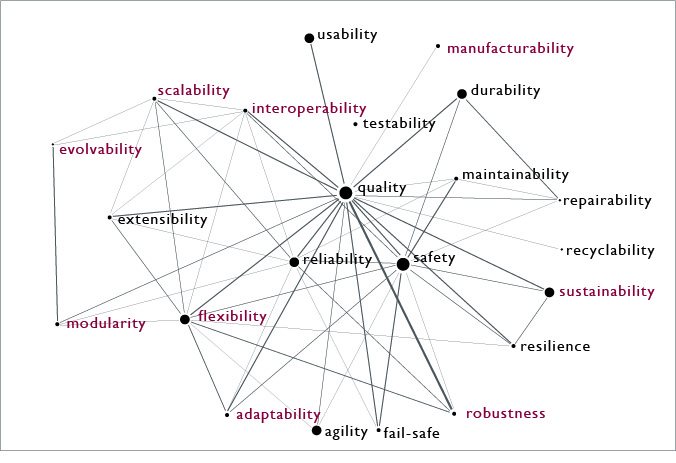MIT Strategic Engineering

Lifecycle Properties (the "Ilities")
We are very interested in better understanding and deliberately designing lifecycle properties into systems. Lifecycle properties are those characteristics of systems that are not the immediate functionality that is apparent when they are first turned "on", but their long-term properties such as how well they hold up over time (reliability, durability), how likely they are to fail and cause harm (safety, resilience), how easy they are to change if needed (flexibility, changeability, adaptability ...) and how well they work with others (interoperability).
The following graphic shows the relationship of a set of 22 most common ilities to each other. The size of the nodes relates to the number of scientific papers written on each system property while the line weight indicates the strength of the diadic relationship. System properties in color indicate those that are of most interest to us.

to read about this graphic: Book Chapter about the Ilities: Chapter 4 from "Engineering Systems: Meeting Human Needs in a Complex Technological World" by de Weck O., Roos D. and Magee C, MIT Press, January 2012 [PDF] - proof version.
Paper on lifecycle properties at CESUN 2012 conference:
de Weck O.L., Ross A., Rhodes D., “Investigating Relationships and Semantic Sets amongst System Lifecycle Properties (Ilities)”, 3rd International Engineering Systems Symposium, CESUN 2012, TU Delft, The Netherlands, June 18-20, 2012
We are mainly concerned with how complex systems and products change over time and how they can be deliberately designed for change. Changeability is an umbrella term that captures the degree to which a system can undergo modifications in its configuration without incurring large increases in its complexity and cost. Flexible systems are those that exhibit a high degree of changeability. Systems that cannot be easily changed are often referred to as suffering from "lock-in".
Lock-in is known as a phenomenon where better technologies or architectures are known to exist, but sub-optimal systems continue to be operated due to high switching costs. In order to avoid lock-in, systems can be designed with embedded flexibility to lower future switching costs and optimize performance and cost under uncertainty. We pinpoint where and how to embed flexibility during system design to promote better system evolution over time. One particular form of system evolution is the infusion of new technologies into existing products and systems. Reconfigurability is a specific kind of changeability where systems can change reversibly between a finite number of configurations with relative ease.
Our contributions in the area of lifecycle properties include:
- Change Propagation Analysis to understand how changes can cascade in Engineering Design. Recent developments include multi-layer representations of system elements, change requests and people involved in the design process
- Staged Deployment Strategy for Complex Systems (e.g. Satellite Constellations) - rather than building systems "all at once" they can be designed in stages with predefined interfaces
- Flexible Product Platform Development Process - product platforms with embedded flexibility to change and serve new market segments
- Theory of Reconfigurability in System Design - reconfigurable systems can reversibly change configurations quickly and with relative ease to fulfill different roles or allow for graceful degradation
- Technology Infusion Analysis - the ability to evaluate technologies not in isolation but in the context of the host systems or products in which they will exist
- Time-Expanded Decision Networks (TDN) - a method for evaluating system designs and strategies across time and subject to different sources of uncertainty
-
Designing Systems for an Uncertain Future (early overview presentation)
Presentation - November 7, 2006 [PDF]
